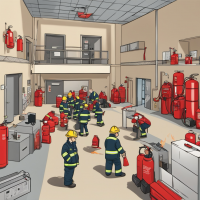
Workplace safety is a top priority for businesses of all sizes and across all industries. Among the various hazards that can threaten employee well-being and disrupt business operations, fire stands out as one of the most destructive. Fortunately, one of the most effective tools for preventing fire-related incidents is a fire risk assessment. When properly implemented, fire risk assessments serve as the cornerstone of a proactive fire safety strategy, significantly reducing the chances of fire outbreaks and ensuring that, if a fire does occur, people know exactly how to respond.
In this article, we’ll explore what fire risk assessments are, why they matter, how they can be conducted effectively, and the ways they contribute to a safer and more compliant workplace.
What Is a Fire Risk Assessment?
A fire risk assessment is a systematic process used to evaluate the likelihood of a fire occurring in a workplace and the potential consequences if it does. The purpose is to identify fire hazards, assess who might be at risk, evaluate existing fire safety measures, and determine whether more needs to be done to reduce the risk to an acceptable level.
This process typically involves:
- Identifying fire hazards (sources of ignition, fuel, and oxygen)
- Determining who might be at risk (employees, visitors, contractors, etc.)
- Evaluating the adequacy of current fire prevention measures
- Documenting the findings and implementing improvements
- Reviewing and updating the assessment regularly
Why Fire Risk Assessments Matter
- Legal Compliance
In many countries, fire risk assessments are a legal requirement under health and safety laws. Employers have a duty to protect workers and visitors, and failing to carry out regular fire risk assessments can result in serious penalties, fines, or even imprisonment in the event of a fire-related incident. - Employee Safety
A well-conducted fire risk assessment can highlight overlooked hazards and enable employers to take corrective action before a fire occurs. This proactive approach helps ensure the safety of everyone in the workplace, especially in high-risk environments like manufacturing plants, warehouses, or facilities handling flammable materials. - Property Protection
Beyond the risk to human life, fires can cause immense damage to property, equipment, inventory, and critical data. Fire risk assessments help minimize these risks by identifying vulnerable areas and recommending fire-resistant materials, better storage practices, and safer electrical systems. - Business Continuity
Fire can shut down business operations for days, weeks, or even permanently. With proper risk assessments and mitigation strategies, companies can avoid costly disruptions and maintain continuity even in the face of emergencies.
Key Steps in Conducting a Fire Risk Assessment
- Identify Fire Hazards
Begin by walking through the workplace and looking for potential sources of ignition (e.g., electrical equipment, heaters), fuel (e.g., paper, chemicals, furniture), and oxygen (e.g., air conditioning, ventilation). This should include less obvious hazards like overloaded plug sockets or improperly stored flammable liquids. - Determine Who Is at Risk
Consider who might be in harm’s way during a fire—employees, temporary workers, night-shift staff, visitors, or those with mobility challenges. Special consideration should be given to how they will evacuate the building safely. - Evaluate Fire Safety Measures
Check the availability and effectiveness of fire alarms, extinguishers, emergency lighting, exit signs, and escape routes. Fire doors should not be propped open, and all escape paths should be clear of obstructions. - Record Findings and Implement Action Plan
Document the hazards identified, who is at risk, and what measures are in place. Then, create a clear plan to address shortcomings. This might involve upgrading equipment, providing staff training, or improving signage. - Review and Update Regularly
Fire risk assessments are not a one-time task. They should be reviewed at least annually or when significant changes occur in the workplace, such as renovations, new machinery, or changes in staffing.
How Fire Risk Assessments Improve Workplace Safety
Enhances Awareness
When fire risks are actively assessed and communicated, employees become more aware of potential dangers. This helps foster a culture of safety where everyone takes responsibility for minimizing risks.
Promotes Better Training
Fire drills, emergency response procedures, and the use of fire extinguishers are often highlighted during fire risk assessments. This leads to better training programs and ensures that employees know how to respond quickly and calmly in an emergency.
Encourages Prevention
With a clear understanding of fire hazards, businesses are more likely to invest in preventive measures such as installing flame-retardant materials, improving electrical systems, or reducing clutter in high-risk zones.
Improves Emergency Preparedness
Fire risk assessments also focus on planning for the worst-case scenario. Businesses can develop and test evacuation plans, assign fire wardens, and ensure communication systems are in place—leading to quicker and safer evacuations during real incidents.
Conclusion
Fire risk assessments are more than a box to tick for regulatory compliance—they are a critical part of a robust workplace safety program. By identifying hazards, addressing vulnerabilities, and training staff effectively, organizations can protect their people, assets, and future. When fire risk assessments are taken seriously and updated regularly, they play a vital role in creating a safe, prepared, and resilient workplace.





Leave A Comment